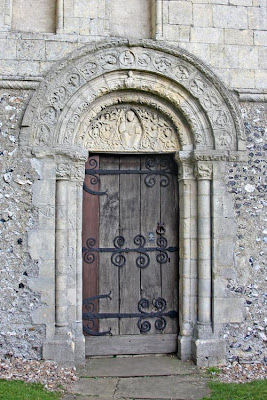Little is known of the original foundation of the church. In A Guide to Barfreystone Church and its World Famous Carvings, F H Worsfold associates it with the de Port family. Hugo de Port, a sub-constable of Dover Castle in 1079, was first granted the Manor of Barfreystone.
Stylistically the carving is late 12th century. The architect R C Hussey who oversaw the restoration in 1840 found that the material had been used before, and some stones had been (and are still!) misplaced in Barfreston Church. He contended that Archbishop Baldwin's chapel at Hackington was the source of the masonry. The Hackington chapel was demolished after the Archbishop's death in 1190, possibly to prevent it rivalling Christchuch Canterbury as a magnet for pilgrims. In its turn, Barfreston became a site on the pilgrim route between Dover and Canterbury.
By the early 19th century the church was falling into ruin, having been damaged in a landslip. In Hussey, it found a supremely conscientious and careful restorer.
 The south side ot the church with the main door (see below) and the The Priest's Doorway (blocked). The hood has characteristic chevron moulding while the damaged tympanum shows a mutilated crown head between two knobs with deep incisions and unknown significance.
The south side ot the church with the main door (see below) and the The Priest's Doorway (blocked). The hood has characteristic chevron moulding while the damaged tympanum shows a mutilated crown head between two knobs with deep incisions and unknown significance. The south doorway. This shows carving of the highest order, most probably the work of the Guild of Masons, based in Canterbury. Major and minor shafts with ornate capitals support an exquisite tympanum. The main subject a Majestas Domini (Christ in Glory) is surrounded by three voussoirs:
The south doorway. This shows carving of the highest order, most probably the work of the Guild of Masons, based in Canterbury. Major and minor shafts with ornate capitals support an exquisite tympanum. The main subject a Majestas Domini (Christ in Glory) is surrounded by three voussoirs:2. The middle voussoir has fantastical representations of animals inspired by medieval bestiaries
3. The outermost depicts more typical scenes of medieval life (possibly the labours of the months?) and a few with scriptural associations.
 The wheel window is Early Victorian although Early English in style and feeling. It is the work of W Miller. The window showing the church's Patron Saint, St Nicholas, was designed by Sir Martin Travers in 1928. The most endearing touch is the church cradled in the saint's left arm, but note the other characteristic symbols - the children, the motif of three golden balls.
The wheel window is Early Victorian although Early English in style and feeling. It is the work of W Miller. The window showing the church's Patron Saint, St Nicholas, was designed by Sir Martin Travers in 1928. The most endearing touch is the church cradled in the saint's left arm, but note the other characteristic symbols - the children, the motif of three golden balls. Barfreston’s bell is 14th century in style. Its “bell tower” is an ancient yew tree in the churchyard. The North Doorway is blocked, note the hood's triple chevron moulding beneath the band of foliage, and the ornate capitals.
Barfreston’s bell is 14th century in style. Its “bell tower” is an ancient yew tree in the churchyard. The North Doorway is blocked, note the hood's triple chevron moulding beneath the band of foliage, and the ornate capitals. Norman wheel windows are much rarer than the rose design. The spokes are colonnettes (round). During the restoration one was found to be wooden and suffering with the ills of ancient wood. It had to be replaced.(perhaps the wooden one was a replacement for an original broken in the 12th century demolition at Hackington). The rich frieze is a medley of winged beasts and foliage which merge into and out of one another in luxuriant abandon.
Norman wheel windows are much rarer than the rose design. The spokes are colonnettes (round). During the restoration one was found to be wooden and suffering with the ills of ancient wood. It had to be replaced.(perhaps the wooden one was a replacement for an original broken in the 12th century demolition at Hackington). The rich frieze is a medley of winged beasts and foliage which merge into and out of one another in luxuriant abandon.
1 comment:
Hi there, are you saying that this church was moved here, lock, stock and barrel?
Post a Comment